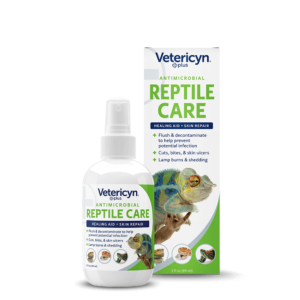Updated April 19, 2025
Reptiles may seem like low-maintenance animals. But their hard exterior is not an impenetrable suit of armor. If you notice soft, oozing, discolored spots on your snake or lizard, your beloved pet may have scale rot.
In this article, we’ll explain how to identify and treat scale rot so your scaly friend’s skin will be in top slithering condition.
What is Scale Rot?
Scale rot, also called ulcerative dermatitis, is skin and scale sores. It usually occurs in snakes and lizards kept in less-than-ideal conditions.
How to Identify Scale Rot
Scale rot may start in one damp area and spread. The longer it goes unchecked, the more likely it is to create a larger problem. Check regularly for early signs of scale rot, including:
- Bad Odor
- Cracked, crusty, raised, or swollen skin and scales
- Discharge
- Red, brown, discolored skin, especially near the tail or on the abdomen
- Loss of appetite

What Causes Scale Rot?
Less-than-ideal living conditions that lead to scale rot include1,2:
- Unsanitary living environment
- Improper habitat humidity and temperature – Your scaly sidekick requires a certain humidity level, but too much moisture can cause scale rot and bacterial infections. Consistently damp bedding, accumulated fecal matter, and improperly heated flooring exposes the scales on a snake’s belly to infections. Maintaining proper temperature and moisture levels is critical to prevent these issues.
- Deficiency of vitamins A or C
However, even snakes and lizards kept in ideal living conditions can develop scale rot. The problem begins internally, causing bleeding into the scales which become pustules and then abscesses.1
Getting Rid of Scale Rot
You can start to treat your reptile’s scale rot at home. However, it can progress quickly, so if it worsens or any other symptoms develop, consult your veterinarian for comprehensive treatment.2
1. Clean and Sterilize the Enclosure3
Wear gloves when handling the cage and its contents and wash your hands thoroughly, even if you wore gloves, after handling your pet or its cage. Clean up spills, food, skin, urates, and feces daily and a do a deep enclosure clean once weekly to help prevent scale rot.
If your pet has scale rot, follow these steps and repeat them weekly. If your pet doesn’t have scale rot, do this weekly to prevent it and other problems.3
Place your reptile in a clean, dry, temperature-appropriate, short-term container with dry substrate while you clean their permanent home.
- Remove and clean – Dispose of all bedding and porous materials. Thoroughly clean all dishes, bowls, and accessories in hot, soapy water. Dry completely, absorbing residual water with a paper towel.
- Clean the cage – Clean the entire surface of the enclosure with hot water and dishwashing liquid, then rinse thoroughly. All organic compounds must be removed before the next step.
- Disinfect – Use a product that is safe for your pet but kills pathogens. Pick up a reptile-safe disinfectant from your veterinarian. Thoroughly disinfect and rinse the cage far away from your pet, as reptiles are sensitive to fumes. Wear gloves and protective eyewear to prevent contact with enclosure materials and the disinfectant.
- Let it dry – Dry everything thoroughly before moving your pet back in.
- Wash your hands – Wear gloves. Wash your hands afterward.
2. Adjust the Temperature and Humidity
How Humid Should It Be?
There’s no magic number for enclosure humidity. It varies by species and time of year. You’ll know the enclosure is too humid when the substrate doesn’t dry between misting. Increasing ventilation or reducing misting will decrease humidity.
What’s the Right Temperature?
Reptile body temperature depends on their environment: when they’re cold, they bask in the sun to warm up, and when they’re hot, they cool off in the shade.
Managing body temperature is more complicated for reptiles in captivity. They can move toward or away from the enclosure’s heat source, but they don’t have the sun and shade like their wild cousins. This is why it’s so important to maintain the perfect temperature for our captive reptile friends.
The temperature also varies for each species and season but have cooler end and a warmer end. Talk to your veterinarian about the right temperature range for your pet.
If the enclosure isn’t warm enough, damp substrate persists. Raising the temperature slightly can decrease the risk of mold and bacteria growth.
3. Clean the Infected Skin
Now that the pet’s habitat is clean, dry, and ready, it is time to consider a mild topical disinfectant to treat the sores directly.
To clean ulcers:
- Betadine (povodine-iodine) bath – Fill a large container with lukewarm water, enough for the reptile to submerge to chest level (you don’t want it any deeper to prevent accidental drowning). Add a few drops of betadine to the water to make the water a medium tea color. Soak for half an hour, then dry with a towel. Gently remove crusty material as you dry your pet. If your pet defecates during the soak, remove the pet from the soak, rinse all sores with water, clean the bathing container, create a new water-betadine bath, and begin the soak again. 4
- Antimicrobial spray – Apply safe and effective spray. Vetericyn Reptile Care Spray is a safe way to clean and moisturize infected scales and open wounds, providing relief and promoting healing. Apply the spray to the affected areas three to four times daily for optimal results.
It’s crucial to maintain consistent treatment and keep the enclosure as clean as possible. If symptoms worsen or persist, schedule an appointment with your veterinarian.

Scale Rot is Nothing to Hiss At
If you think your scaly friend has scale rot, don’t get too rattled. Call your veterinarian for advice. In the meantime, there’s plenty you can do at home to help prevent and treat it. Keep your pets healthy, clean their habitat regularly, maintain proper temperature and humidity, and keep helpful products like Vetericyn Plus Antibiotic Reptile Care spray on hand for routine care. Learn more about our pet care products at Vetericyn.com.
 Reviewed by Dr. Kathy Adamson
Reviewed by Dr. Kathy Adamson
Dr. Kathy Adamson earned her bachelor’s degree from the University of Notre Dame and her Doctor of Veterinary Medicine degree from the University of Wisconsin-Madison School of Veterinary Medicine.
She completed a one-year small animal medicine and surgery internship at the North Carolina State College of Veterinary Medicine. Alongside her studies, Kathy worked in a research lab, contributing as an author and co-author to various journal articles.
She has also pursued medical writing and editing certification through the University of Chicago Graham School. Currently, she runs KMA Veterinary & Medical Writing, a freelance medical writing company, serves as the Digital Content Manager for the Greater Chicago Area Chapter of the American Medical Writers Association, is a member of the AMWA Communications Committee, and enjoys writing about healthcare topics for people and their cherished pets.
![]() https://www.linkedin.com/in/kathyadamsondvm/
https://www.linkedin.com/in/kathyadamsondvm/
Sources:
- Divers SJ. Bacterial Diseases of Reptiles. VIN.com. Published online September 17, 2021. https://www.vin.com/doc/?id=10475032
- Brahlek A. Identifying and Treating Scale Rot. VetMedX Animal Wellness. April 27, 2021. Accessed March 26, 2025. https://vetmedx.co.za/identifying-and-treating-scale-rot/
- Petco’s Animal Care, Education, and compliance (ACE) Team. How to Clean and Disinfect Reptile Cages. Accessed March 26, 2025. https://www.petco.com/content/content-hub/home/articlePages/01/habitats-cleaning-and-disinfecting-reptile-cages.html
- Kaplan M. First Aid for Reptiles. anapsid.org. Accessed March 26, 2025. https://www.anapsid.org/emergency/firstaid.html
